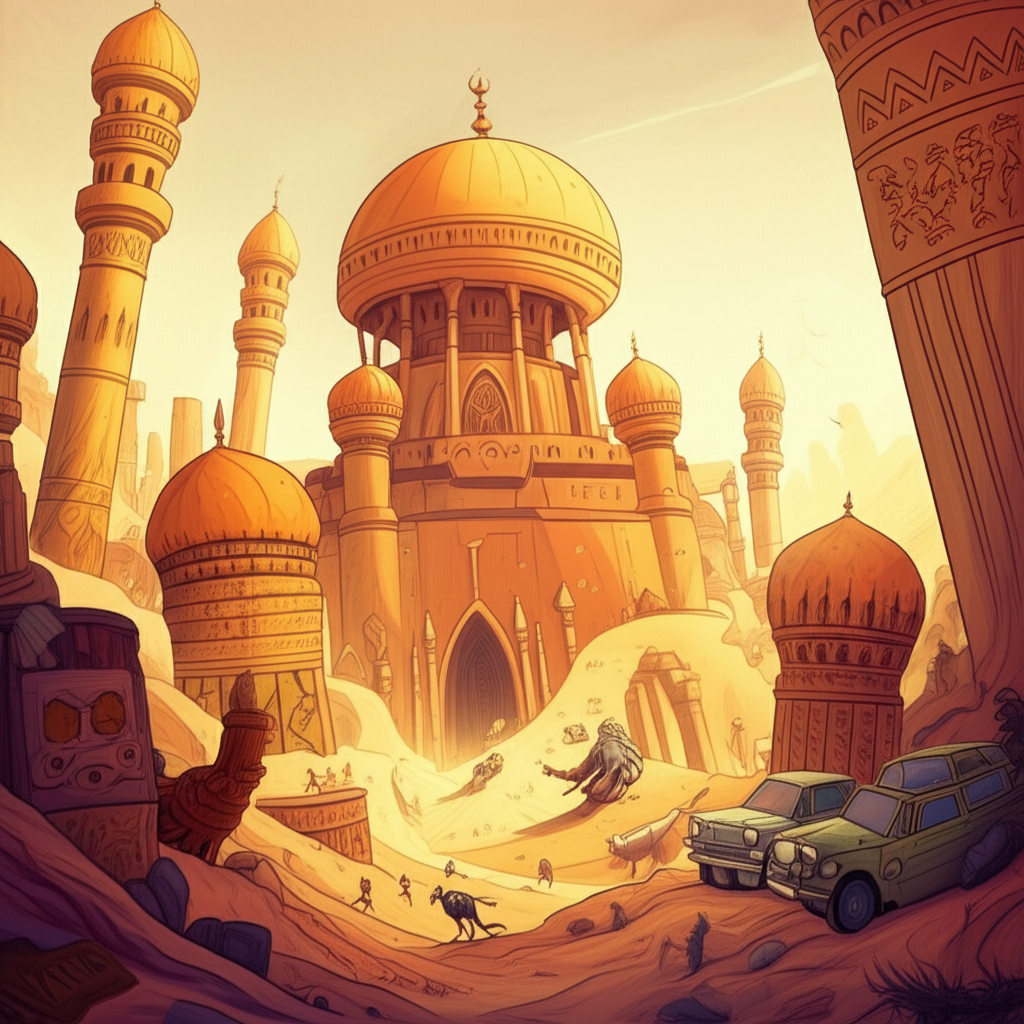
The vast, shifting dunes of the Arabian Peninsula have long been the silent keepers of secrets, their arid expanse a canvas upon which ancient peoples painted their deepest fears, grandest dreams, and profoundest questions about existence. Among the most enduring and evocative of these tales is that of the City of Brass, a mythical metropolis lost to time and sand, whose legend resonates with the echoes of human ambition and the stark reality of mortality. This is a story woven into the rich tapestry of Middle Eastern folklore, specifically finding its prominent place within the beloved collection of One Thousand and One Nights, or Arabian Nights, not as a factual account, but as a traditional narrative passed down through generations by ancient storytellers.
Origins and Cultural Background: A World of Wonders and Wonders Yet Unknown
The legend of the City of Brass, like many tales within One Thousand and One Nights, originates from a cultural era steeped in intellectual curiosity, rich oral traditions, and a vibrant exchange of ideas. While the compilation of One Thousand and One Nights reached its definitive form during the Islamic Golden Age, particularly under the Abbasid Caliphate (roughly 8th to 13th centuries CE), its component stories draw from much older Persian, Indian, and Mesopotamian traditions, adapted and infused with Arab-Islamic cultural elements. This was a time when scholars translated and preserved ancient texts, when cartographers charted known lands and speculated about the unknown, and when poets and storytellers captivated audiences with tales of adventure, romance, and the supernatural.
The people of this era viewed the world through a lens that seamlessly blended the tangible with the unseen. The vast deserts, like the foreboding Rub’ al Khali (the Empty Quarter) – a place so immense and desolate it was believed to harbor unseen forces and forgotten histories – were not merely geographical features but realms of mystery. Jinn, powerful elemental beings mentioned in pre-Islamic lore and the Quran, were believed to inhabit these desolate places, capable of both immense creation and destruction. The idea of magnificent, ancient civilizations that had risen and fallen, leaving behind only ruins and whispers, was a potent theme, serving both as entertainment and as a moral reflection on the transient nature of worldly power. Myths like the City of Brass offered a framework to understand the vastness of time, the limits of human endeavor, and the enduring power of divine will over all creation.
The City of Brass: A Silent Monument to Transience
The central "figure" in this narrative is not a living creature or a singular being, but the City of Brass itself – a fantastical, almost sentient monument. It is described as an architectural marvel, its immense walls and gates purportedly crafted from shining brass, reflecting the sun like a distant beacon. Within its precincts, according to legend, stood palaces of exquisite beauty, populated by silent, perfectly preserved inhabitants – kings, queens, and their courtiers, frozen in time, adorned in their finest regalia. The city’s defenses were equally wondrous and terrifying: automatons of brass, riders on horseback, and formidable gates that moved with uncanny precision, all serving to guard its secrets.
Symbolically, the City of Brass is a profound representation of human hubris and the ultimate futility of worldly power and material wealth in the face of time and divine decree. It embodies the allure of forbidden knowledge and the mystery of lost civilizations. Its brass construction, while suggesting strength and resilience, also hints at the cold, unyielding nature of a place devoid of life. The preserved inhabitants are not glorious deities or fearsome monsters, but rather poignant reminders of mortality, their opulence serving only to highlight their inevitable end. It stands as a silent, glittering tomb, a testament to what once was and what can never endure forever.
The Quest for the Lost City: A Narrative of Discovery and Humility
The tale, as recounted in One Thousand and One Nights, begins with a Caliph, often identified as Abd al-Malik ibn Marwan, who stumbles upon ancient texts mentioning the legendary City of Brass and its marvelous artifacts, including vessels fashioned by the Prophet Solomon himself. Driven by curiosity and a desire for knowledge, the Caliph dispatches his loyal general, Musa ibn Nusayr, on a perilous expedition to locate this fabled city, hidden deep within the desolate expanse of the Rub’ al Khali.
Musa and his caravan embark on an arduous journey, traversing endless dunes under the scorching sun. Their path is fraught with hardship: thirst, hunger, sandstorms that blot out the sky, and the ever-present fear of the unknown. They encounter strange ruins, colossal monuments half-buried by sand, and decipher ancient inscriptions that hint at a glorious past and a forgotten people. These discoveries fuel their determination, pushing them deeper into the heart of the Empty Quarter, a place where the line between reality and legend blurs.
After months of relentless travel, just as their hopes begin to wane, a shimmering spectacle appears on the horizon – the City of Brass. Its towering walls, fashioned from gleaming metal, pierce the sky, a breathtaking sight in the desolate landscape. The city stands utterly silent, its immense brass gates sealed, guarded by colossal figures of brass horsemen with lances poised, their eyes seemingly following every movement.
The entry into the city proves to be a formidable challenge. Musa’s engineers and scholars eventually decipher the intricate mechanisms, unlocking the massive gates with a resounding clang that echoes through the empty streets. What they find inside is both awe-inspiring and profoundly unsettling. The city is a marvel of urban planning and artistic splendor, with grand avenues, intricate palaces, and gardens that once bloomed. Yet, it is utterly devoid of life. Instead, they discover its inhabitants perfectly preserved, seated on thrones, reclining on couches, or standing in various poses, their clothes and jewels intact, their skin like parchment. They are not mummies, but rather bodies frozen in time, a chilling tableau of a civilization halted in its prime.
Musa and his men move through the silent city, their footsteps the only sound. They find no gold, no jewels they dare to touch, for the sheer majesty and mournful silence of the place instill a deep reverence and fear. Instead, they discover inscriptions etched into walls and tablets, ancient warnings from the city’s long-dead kings. These inscriptions recount their power, their wealth, their belief in their own immortality, and their ultimate downfall. They speak of a sudden, inexplicable end, a divine judgment that swept through the city, leaving its inhabitants perfectly preserved as a warning to all who would follow. The messages are clear: earthly power is fleeting, and all material possessions eventually return to dust.
Humbled and profoundly affected by this silent testament to human mortality, Musa and his men gather only a few symbolic items – perhaps an inscription, a preserved piece of fabric – as proof of their journey. They leave the City of Brass as silently as they entered, the memory of its eerie grandeur etched forever into their souls.
Symbolism and Meaning: Lessons from the Sands
To the ancient people who told and heard this tale, the City of Brass was far more than a fantastical adventure. It served as a powerful allegory, rich with moral and philosophical meaning:
- Mortality and the Transience of Life: The most overt message is the inevitability of death and the fleeting nature of worldly achievements. Even the most magnificent city, built with unparalleled skill and guarded by wondrous technology, cannot escape the ultimate fate of all things.
- Hubris and Divine Power: The kings of the City of Brass believed their power and wealth would make them immortal. Their preserved state is a stark reminder that only Allah (God) possesses true and eternal dominion, and human arrogance is always met with divine judgment.
- The Desert as a Metaphor: The Rub’ al Khali itself acts as a character – a vast, indifferent force that both conceals and preserves, a symbol of the unknown and the ultimate emptiness of material pursuits.
- Wisdom and Warning: The inscriptions serve as a form of ancient wisdom, a cautionary tale passed down through time, urging humility, piety, and a focus on eternal truths rather than temporary worldly glories.
- The Allure of the Unknown: The tale also speaks to humanity’s inherent curiosity and desire to explore the boundaries of the known world, even when those explorations lead to profound and sometimes uncomfortable truths.
Modern Perspective: Echoes in Contemporary Imagination
Today, the legend of the City of Brass continues to captivate imaginations across various mediums. In modern literature, it serves as an inspiration for tales of lost civilizations, forgotten magic, and perilous desert quests. Fantasy novels often draw on its imagery of silent, wondrous ruins and the discovery of ancient, powerful artifacts. The idea of a perfectly preserved city, frozen in time, has influenced countless narratives exploring themes of immortality, decay, and the remnants of past glories.
In the realm of movies, television, and video games, the City of Brass translates into compelling concepts of ancient, mysterious dungeons, hidden cities guarded by automatons, and the thrill of uncovering long-lost knowledge. It feeds into the universal human fascination with archaeological discovery and the allure of secrets buried beneath layers of history and sand. Culturally, the story is studied as a prime example of Middle Eastern storytelling prowess, reflecting the region’s rich narrative traditions and its unique blend of the historical, the magical, and the moral. It stands as a testament to the enduring power of myths to shape our understanding of the world and our place within it.
Conclusion: A Cultural Tapestry, Not a Creed
The legend of the City of Brass, with its gleaming walls and silent inhabitants, remains a powerful testament to the imaginative spirit of ancient peoples. It is a masterful piece of cultural heritage, a traditional story told by ancient people to entertain, to teach, and to reflect upon the profound questions of existence. It is important to re-emphasize that this is a cultural story, a product of human imagination and storytelling tradition, and not a belief system or a historical account to be taken as truth.
As Muslims, we recognize that only Allah is the true Creator and Sustainer of all that exists, the sole Source of power, knowledge, and dominion. The wonders described in tales like the City of Brass are magnificent constructs of human fancy, designed to explore themes relevant to the human condition. Such narratives serve as parables, products of human creativity and a yearning for understanding, rather than divine revelations or objects of worship. They allow us to connect with the wisdom and worldview of past generations, appreciating the artistry of their storytelling and the lessons they sought to impart, while always affirming our faith in the One True God. The echoes of the City of Brass in the sands of time remind us of the enduring legacy of imagination and the timeless human quest for meaning.





